Homemade Paczki (Polish Doughnuts)
Paczki are traditional Polish doughnuts that are made from a rich brioche-style dough, filled with your favorite fruit preserves and rolled in sugar. These are served on Paczki Day (i.e. Fat Tuesday) here in the U.S. and on Fat Thursday in other parts of the world!

I first heard of pączki nearly a dozen years ago, when I noticed them at the grocery store right before Lent. I did a little digging and found that they are Polish pastries similar to jelly donuts. They are traditionally made and eaten on Fat Tuesday and Fat Thursday (I had never heard of Fat Thursday before researching these!).
As it turns out, Fat Thursday (called Tłusty Czwartek in Poland) is a Christian feast marking the last Thursday before Ash Wednesday. Traditionally, it is a day dedicated to gathering with friends and family to eat large quantities of sweets, cakes, and other meals often given up during Lent. I couldn't find anything that spelled out a discernible difference between Fat Tuesday and Fat Thursday, except that certain regions and religions tend to celebrate one or the other. The concept is definitely the same - indulge as much as possible right before Lent!
Now, back to the paczki… The difference between these and a basic doughnut is that paczki is made with a very rich, sweet yeast dough consisting of eggs, butter, and milk. Sort of like a brioche doughnut, only better, if you can imagine!
When I started to poke around for recipes, I called my grandma (whose father was from Poland) to see if she had a recipe for paczki. Sadly, she did not but said that her mom used to make them.
So, I started Googling "paczki recipe" and then revised it to "grandma's paczki recipe". I wanted something authentic, and I found more than a handful of recipes that originated with someone's grandma. While all the ingredients were the same, the quantities and methods varied from recipe to recipe, so I pieced together what I thought sounded delicious and started on my way.

The most traditional paczki recipes call for filling the doughnuts with fruit preserves, jam, or prune butter, while others said their grandma never used a filling. Some say they must be rolled in powdered sugar, while others say they have always been rolled in granulated sugar. If you don’t prefer either, go your own way and do a simple glaze!
So, I did a test batch of each: filled/powdered, filled/granulated, unfilled/powdered, and unfilled/granulated. For the filled ones, I did half raspberry and half apricot preserves for the initial testing.
My husband and I taste-tested all of them, and both came to the conclusion that the unfilled ones rolled in granulated sugar were hands down our favorite. Jelly doughnuts were never my thing, so I wasn't surprised that I preferred the unfilled ones. As for the sugar coating, both tasted good, but I love the crunch of granulated sugar on the outside of a doughnut. So hard to beat it!
How Paczki Are Made
These doughnuts start by making a brioche-style yeasted dough that includes milk, butter, an egg, and egg yolks. Once the dough is made, it is placed in a bowl in a draft-free area until it doubles in size.
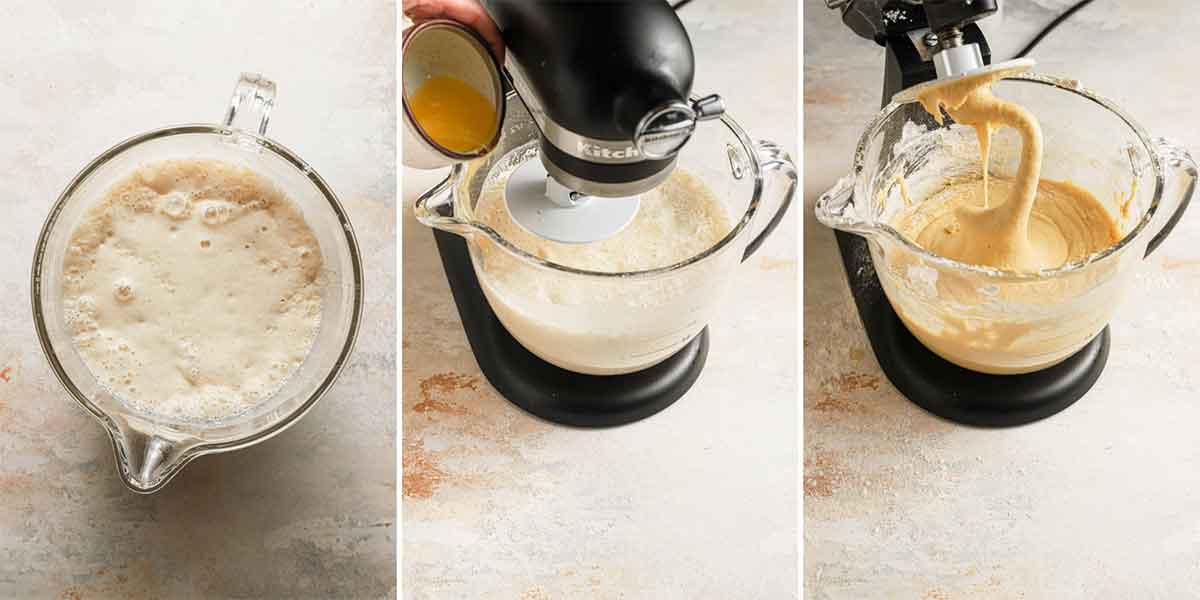
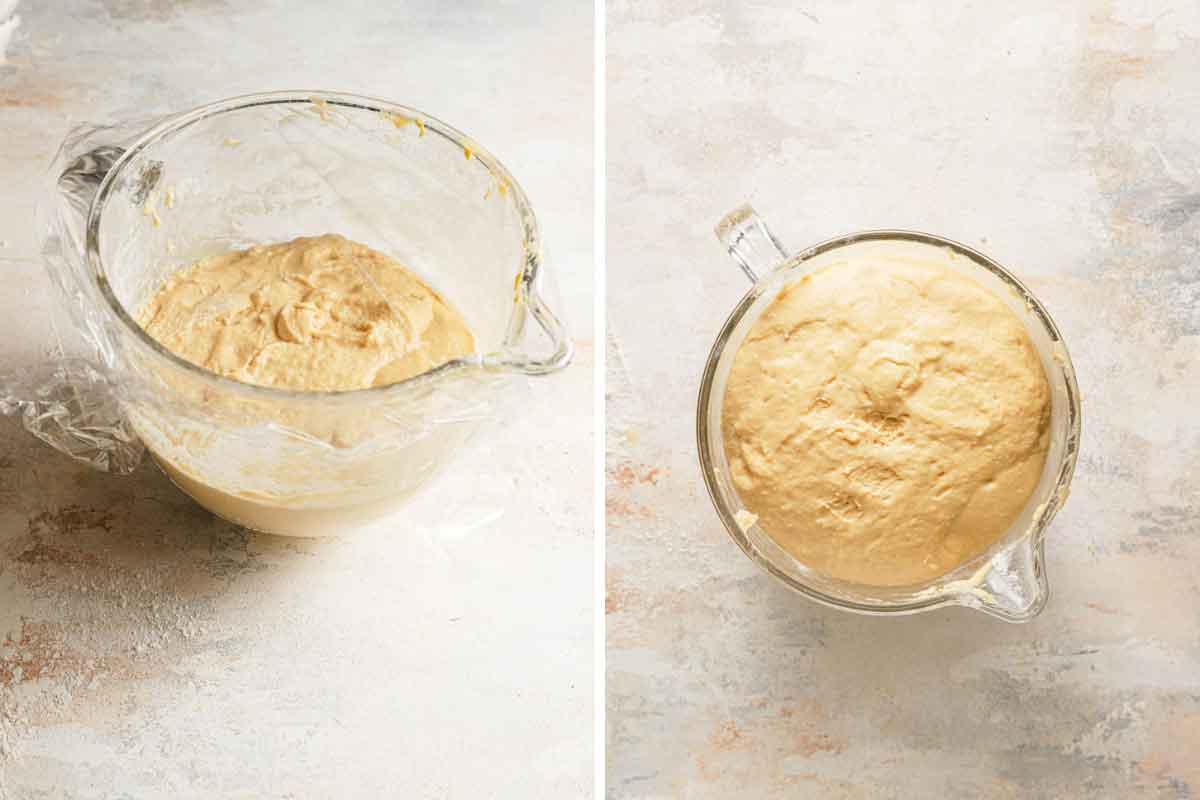
Once doubled in size, the dough is turned out onto a floured surface (I love my silicone dough mat for jobs like this!) and rolled a ½-inch thick. Then, use a 3-inch round biscuit cutter or cookie cutter to cut out rounds of dough. Transfer those rounds to parchment-lined baking sheets. Gather scraps and re-roll to use up all of the dough. Cover those baking sheets loosely with plastic wrap and allow to rest until nearly doubled in size (about 30 minutes).
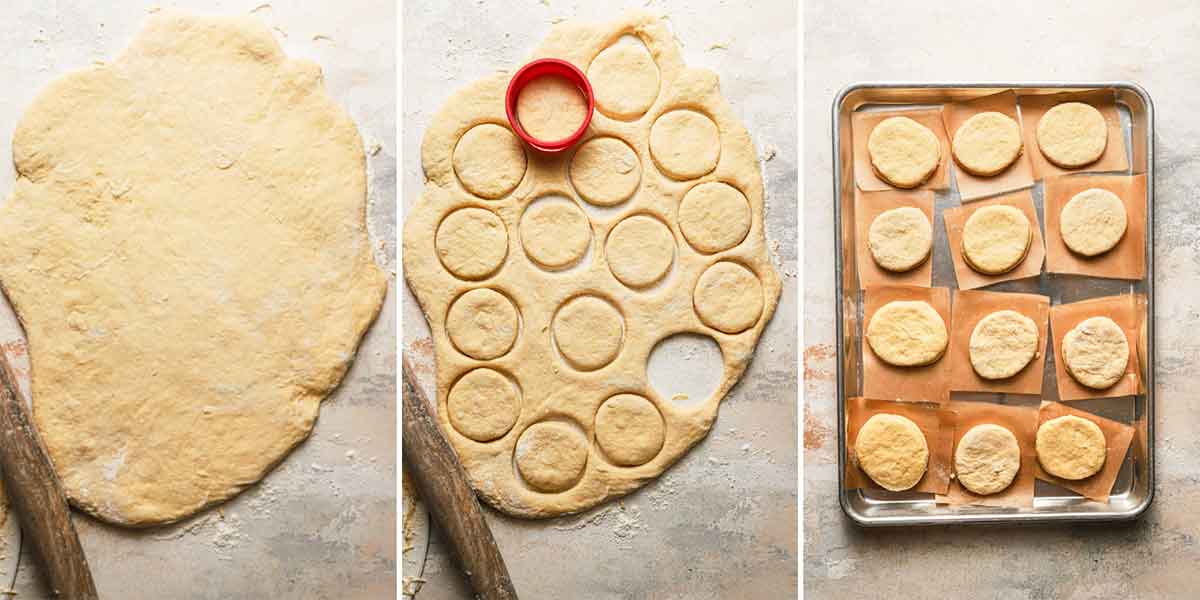
While the doughnuts are rising, begin heating the oil. You can use peanut oil, vegetable oil, lard, or any other oil or fat you prefer for frying. Heat at least 1½ inches of oil, using a large cast iron skillet or Dutch oven, until the oil reaches 350 degrees F (use a thermometer for accuracy).
Lower about five or six paczki at a time into the oil (do not crowd the pan), and deep-fry until the bottom is golden brown, then carefully flip over and fry until the other side is golden brown. Remove to a baking sheet covered with a double layer of paper towels to drain. Let the oil come back to temperature and continue frying the remaining doughnuts.
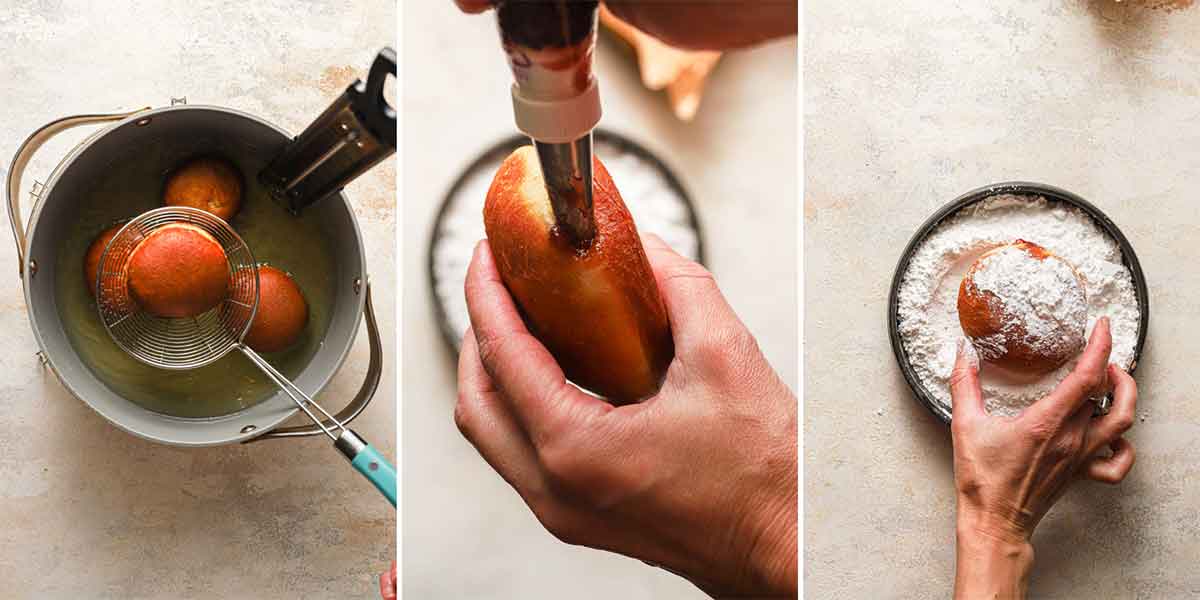
Once the paczki can be handled comfortably, use a piping tip to fill the doughnuts, if desired, then roll in sugar or glaze them as desired.
More Filling Ideas
While you can leave these unfilled, if you prefer a filled doughnut, use your favorite filling! Here are some ideas to get you started:
- Fruit preserves
- Strawberry jam, raspberry jam, or plum jam
- Prune butter
- Lemon curd
- Bavarian cream
- Pastry cream (the recipe linked there is for vanilla pastry cream, but it includes a note on how to make it chocolate, too!)
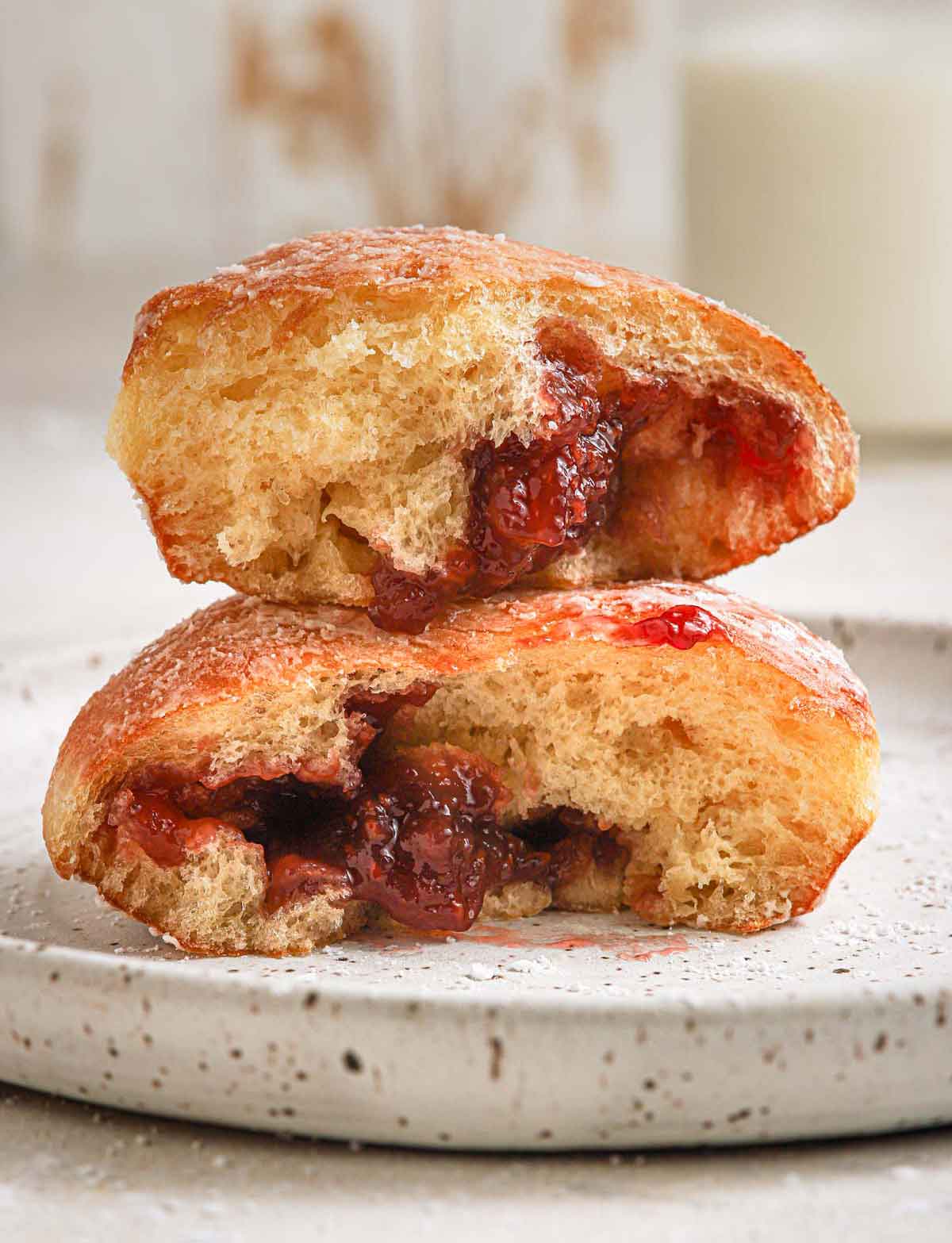
Storage Instructions
Paczki are definitely best eaten the same day that they are made.
However, if you have leftovers, you can store them in an airtight container for up to 2 days.
Watch How to Make Paczki:
More Homemade Doughnut Recipes
- Copycat Krispy Kreme Doughnuts
- Vanilla Cream-Filled Doughnuts
- Apple Fritter Doughnuts
- New Orleans Beignets
- Buttermilk Doughnuts
If you make this paczki recipe and love it, remember to stop back and give the recipe a 5-star rating - it helps others find the recipe! ❤️️
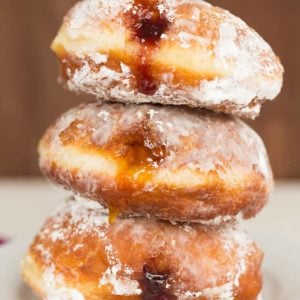
Paczki (Polish Doughnuts)
Ingredients
- 2 cups (480 ml) whole milk, warmed to 110 degrees F
- 4½ teaspoons (4.5 teaspoons) active dry yeast, 2 packages
- ¾ cup (149 g) + 1 pinch granulated sugar, divided
- 5 to 6 cups (709 to 850 g) all-purpose flour, divided
- 1 egg
- 4 egg yolks
- 1 teaspoon vanilla extract
- 1¼ teaspoons (1.25 teaspoons) salt
- 4 tablespoons unsalted butter, melted and cooled
- Peanut oil, canola oil or lard, for frying
- Fruit preserves, for filling
- Powdered and granulated sugars, for coating
Instructions
- Pour warm milk into bowl of a stand mixer. Stir in the yeast and a pinch of granulated sugar. Let stand for 5 to 10 minutes, or until it has become bubbly.
- Add 2 cups of flour to the mixture and stir with a wooden spoon until a smooth batter forms. Cover with plastic wrap and set in a warm spot for 30 minutes. The mixture should have risen and be very bubbly.
- In a medium bowl, whisk the egg and egg yolks until pale yellow and frothy, about 3 minutes. Add the sugar, vanilla extract and salt, and whisk until combined and smooth.
- Attach the dough hook to the mixer, add the egg mixture to the dough and mix on medium-low speed until mostly combined. Add the melted butter and mix to combine. Gradually add 3 more cups of flour to the mixture and continue to knead until a very soft dough comes together. (It will not clean the sides of the bowl or form a ball; it will be rather slack and a bit sticky.) If necessary, add up to another 1 cup of flour, a spoonful at a time, until the dough forms.
- Transfer the dough to a lightly greased bowl, cover with plastic wrap, and set in a warm spot until it has doubled in size.
- Remove the dough from the bowl and turn out onto a floured work surface. With your fingers, push down the dough into an even layer. Sprinkle flour on the dough and roll it out to ½-inch thickness. If the dough doesn’t hold its shape and springs back, cover with a damp towel and let rest for a few minutes and try again.
- Use a 3-inch biscuit cutter to cut out rounds of dough. Transfer the dough rounds to parchment-lined baking sheets. Gather scraps of dough and again roll out and cut until you have used up all of the dough. Cover the baking sheets loosely with plastic wrap and place in a warm, draft-free spot until almost doubled in size, about 30 minutes.
- Meanwhile, heat at least 1½ inches of oil in a heavy-bottomed pot or deep skillet (I used a 12-inch cast iron skillet) over medium heat to 350 degrees F. Carefully lower about six paczki into the oil at a time (be sure not to over-crowd the pan) and fry until the bottom is golden brown. Carefully turn them over and continue to fry until the other side is golden brown. Use a spider strainer or slotted spoon to remove them to a paper towel-lined baking sheet to drain. Allow the oil to come back to temperature, then repeat until all of the paczki have been fried.
- Allow the paczki to cool until you are able to handle them easily. Using a filling tip, pipe fruit preserves into the sides of the paczki, then roll in sugar. The paczki are best the same day they are made, but can be stored in an airtight container at room temperature for up to 2 days.
Notes
Did you make this recipe?
Leave a review below, then snap a picture and tag @thebrowneyedbaker on Instagram so I can see it!
Photography by Dee Frances
Save This Recipe
This recipe was originally published on February 26, 2014.






I just want to say how much I love your blog and to thank you for helping me stretch my wings as a cook. Over the weekend I made your Italian wedding soup recipe and yesterday I made a batch of paczki, both are foods I love but always assumed were beyond my skill. Where I live pazcki day is a big deal and I’ve had just about every kind from every kind of place but yours were amazing! Thank you, thank you, thank you!
Hi Anne, You are so sweet, thank you for taking the time to comment. I’m so happy to hear you’ve been enjoying the recipes! :)
Hi Michelle,
I made Paczki for the first time last weekend. They are delicious and I will never buy them at Giant Eagle again. Thank you for researching and trying recipes and giving us the best one.
Hey! This is so cool! I’m from India but I live in Poland- and we have a true abundance of fluffy, jam-injected Pączkis! It’s so exciting to see someone foreign make them because I feel like a lot of people don’t know how awesome Polish food is :)
I an a native Chicagoan….with (like most people in Chicago) tons of Polish friends. Eating Paczki was a normal part of my life that I looked forward to in the run up to the Lenten season until I moved to the south (Memphis) where no one here seems to have ever heard of them. I am seriously craving this this year and may take a crack at this recipe tonight!
to re-heat: My Mom would put these in a paperbag and put them in the oven on a low temperature the next day. Tastes fresh again!!! Better than the microwave….
i am from berlin germany we call them pfannkuchen and eat them also on new years eve .
Hi Michelle, I attempted to make these today. The problem I had is after I cut them and let them rise again. As soon as I tried to pick them up (they were very sticky), they deflated and what I ended up with was free form fried dough that were flat and hard to fill. How do you remove them neatly from the parchment paper to drop in the oil?
Hi Barbara, Almost all of them came right up easily (I was very gentle when I picked them up). A few of them stuck, and I just floured my fingers and they came up just fine. I hope that helps!
if anyone of you will be visiting Warsaw, I recommend to buy few donoughts in the bakery on Chmielna street. My most favourite donoughts with rose filling.. OMG moist, warm and just melting in your mouth. on Fat thursday Polish also make faworki, it is quite simple and also fried recepie but very crunchy comparing to donoughts. you can find recepie and translate it with google translator.
I grew up eating paczkis in MIchigan, they are not as popular on the East Coast; love them!
Wow I was surprised when I saw pączki recipe on your blog. :)
I’m from Poland and yes, we have Fat Thursday. There are always plenty of queues for pączki – calssic with rose jam inside. But there are a lot of variations: with toffi, vanilla pudding, blueberries or advocaat. But classic are the best!
We deep fry FAWORKI ( or chrust) too. If you don’t know them, you should check it. There are crispy things sprinkled with caster sugar.
After Fat Thursday we have something like Fat Tuesday. We eat pączki and sometimes children go from home to home, singing and collecting sweets or money (like on Halloween). :)
Best wishes from Poland, love your blog.
Malwina
I’m glad to hear you say you like the unfilled best! I grew up in a polish church (in Michigan) and they’ve been making a non-filled paczki recipe for decades now. It originally came from someone’s family in the parish They cover theirs in powdered sugar. Pop those babies in The microwave for a few seconds and it’s glorious!
Was recently in Warsaw where I sampled many different paczki! The traditional ones are filled with rose jam, and sometimes topped with candied orange rind; it’s so wonderfully fragrant! They were also glazed and not rolled in granulated or powdered sugar!
Hi…
I am amazed at your talent! My daughter is moving her bakery (in Nevada) to a location that will allow her to have a fryer. Can you tell me what kind of donut maker you have. Thanks so much for all your wonderful posts!
Hi Tanya, I’m not sure what you mean by donut maker? I just cut them out with a round biscuit cutter and fried them in my 12″ cast iron skillet. I hope that helps!
I am dying right now. This makes me realize I need to get back in the kitchen baking again.
I have GOT to try these! I’m obsessed with doughnuts but I’ve never made this kind. They look perfect!
I too had never heard of paczki. They sound and look lovely. I love the readers suggestions of rose petal jam.
I did some digging and I asked my boyfriend’s mom about Paczki and many many years ago when she was a little girl Pączki were rolled in sugar as you said. They also made Paczki without any filling. But now is as I said in my previous comment. So your recipe and explanation is very very true :)
Hi,
I’m Polish and I love pączki. Yours looks very nice. I would taste them. We celebrate Fat Thursday (nothing but Fat Thursday, not Fat Tuesday, Friday etc.) eating lots of pączkis and faworki (angel wings) – you could try to make them too :-)
P.S. The most popular filling for pączki is jam made from rose petals. Together with fluffy pączek it’s heavenly good! But we use also vanilla pudding, strawberry jam or soft chocolate.
These look incredible! Doughnuts are totally my weakness, which is why your beautiful homemade ones look like heaven to me. Your photographs are gorgeous!! :)
Oh wow these look so good! I love that you tried out all the different combinations!
I’m heading to Poland again this summer…. I’ll have to look for these in a bakery. They look YUM!
The ones filled with jam and rolled in powdered sugar look just like the ones in all the bakeries in poland. Yum! And traditionally (according to Mum), it was always rose petal jam :-)
What a great and timely post — well done. :)
Thanks, Bob!
Which do you prefer to use when baking bread, active dry yeast or instant yeast? Thanks.
Hi Ela, It all depends on the recipe, really. I’ve used both.
I was never ever expect to see recipe for Pączki on your blog! So great to see this here. I love your blog because I can find here real recipes for American sweets and I found here very good recipe for Pączki.
Traditional Polish Pączki look exactly like yours but they are not roll in sugar. They should look like this http://www.mojewypieki.com/przepis/paczki-przepis-iv and they have to be always filled with rose jam.
About Fat Tuesday – does not exist. We have Fat Thursday and the last day of the Carnival we call Ostatki – Shrovetide (the last day when we can eat Pączki and other fat sweets).
But everyday in our bakery’s we can buy Pączki. I actually eat Pączki from time to time as my second breakfast at work and I’m not alone in this. But we only make them at home during the Carnival and especially for Fat Thursday. In my Town – Cracow we have also on this day a competitions: which bakery this year sold the best Pączki. This is like the best award for bakery in me town :)
In my family pączki without filling are called “beznadziejne” (meaning terrible or useless) because filling in Polish is “nadzienie” and “bez” means without. Yours look great, though, only store bought pączek would be filled by a pipe. In my family the most popular filling is sour cherry jam.
I have never heard of paczki before, but now I want some. I may need to make these for Fat Tuesday &/or Thursday! I have never heard of Thursday either!
How can you tell when dough has doubled?
Hi Judy, I actually use a straight-sided container (this one: http://www.kingarthurflour.com/shop/items/flour-bucket-small), put the dough is, measure how high up the side the dough is, then double it and place a piece of tape on that doubled mark. When the dough gets to that mark, it’s doubled :) For instance, if I use a ruler when I put the dough in the container and see that it comes 3 inches up, then I place a piece of tape 6 inches up. There are also some dough-rising containers with marks.
This looks completely delicious… How much oil did you use for frying?
Hi Monika, I recommend filling the pot or pan with 1½ to 2 inches of oil.
Awesome; thanks for the follow up!
I can’t wait to try these as my husband is Polish & would love them! I had a couple questions though: I know you said you could use a few different kinds of oil, but which did you use & recommend? Also, how much oil should I put in the skillet/pot? Do you want the paczki submerged or just half in? Thanks so much!
Hi Elizabeth, I used peanut oil (I still have a ton left from our deep-fried turkey at Thanksgiving). The paczki only need to be half in the oil. I would add about 2 inches of oil to your skillet or pot (if using a skillet, be sure it has high sides).
Michelle, I’ve been meaning to come back and thank you for your response. :) I haven’t made these yet, but was planning to tomorrow. One other question if you have a sec, when you put these or any type of bread that needs to rise in a “warm” spot in your house, where do you put them, and what’s considered warm? I don’t have a warmer, and am always at a loss as to where to warm things. Thanks so much!!
Hi Elizabeth, I would put them in an oven (that’s not turned on) and turn on the light. That will keep it free of drafts and give it a little ambient heat. Enjoy the paczki!
You’re awesome for getting back to me so quickly! And thank you, I’m so glad to know that little trick about a warm spot :) Have a wonderful weekend with those 2 Goldens of yours!
When I used to work the bakery at Wal-mart making doughnuts, there was a version of these that I loved. I can’t wait to give these a try!